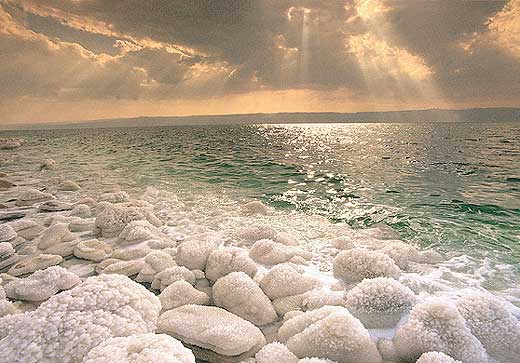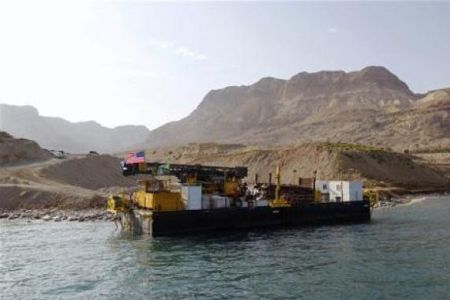Dead Sea secrets to fight global warming?
Source: presstv.ir

A group of engineers and scientists have decided to control climate change and natural disasters by exploring the bed of the Dead Sea, the deepest point on earth.

A drilling platform is moored offshore in the Dead Sea on November 16, 2010.
The group started extracting layers of the earth’s core on Sunday and plan to continue until they reach a depth of 1,200 meters below sea level.
The rig, which is operated by the Utah-based non-profit DOSECC Exploration Services, will drill a five-cm-wide hole and core samples will then be sent to be analyzed and archived, said operations manager Beau Marshall.
"We’ve drilled a lot of fresh water lakes, we’ve done some salt water activity as well, but the Dead Sea is quite unique," Marshall said.
"It’s going to require us to keep everything well lubricated and cleaned up because the salt will wreak havoc on our equipment."
Like the rings on a tree trunk, sediment layers can tell the sea’s history. The sea bed adds two layers of sediment every year and researchers hope they can analyze 500,000 years of geological history by extracting and studying the sediment layers.
"The sediments of the Dead Sea are the best climate and earthquake recorders for the entire Middle East," Reuters quoted project head Zvi Ben-Avraham as saying.
Ben-Avraham says the Dead Sea collects water run-off from the Sinai desert in Egypt up to the Golan Heights, which covers an area of about 42,000 square kilometers.
It also lies on a fault line between two continental plates which move at different speeds causing much tectonic activity.
The team hopes to get new information on ancient rainfall, floods, droughts and earthquakes, use them in environmental studies and figure out a way to fight global warming.
It also tries to find an explanation for the Dead Sea’s receding shoreline in recent years, which scientists blame on regional water mismanagement.
The project is part of the International Continental Scientific Drilling Program, which has conducted studies across the globe in an effort to test geological models and find the best way to manage the earth’s resources and environment.
The Dead Sea is a 378-meters-deep lake known as one of the world’s saltiest bodies of water. It owes its name to its hypersaline quality which does not let animals flourish.
The Dead Sea has attracted visitors from around the Mediterranean basin for thousands of years. It was one of the world’s first health resorts and its salt and minerals are used in cosmetics and herbal sachets.
Article from: presstv.ir






















